By Daoke
As we all know, we write programs to dynamically implement the logic required by our applications and run the programs to get the results we need. Database is an application that quickly obtains data by entering SQL strings. If there is no such system application like databases, how can we obtain data using programs? We may find that we still need to constantly modify programs to process different requests for data from different applications, regardless of data storage mode and concurrent data access. For example, we usually obtain data in the big data field through APIs of non-relational databases. This method is simple to get started, but it is extremely difficult to maintain and not so generic. Even if software architecture design or abstract refactoring is continuously carried out, it is still necessary to continuously transform applications. This is why non-relational databases embrace the SQL optimizer.
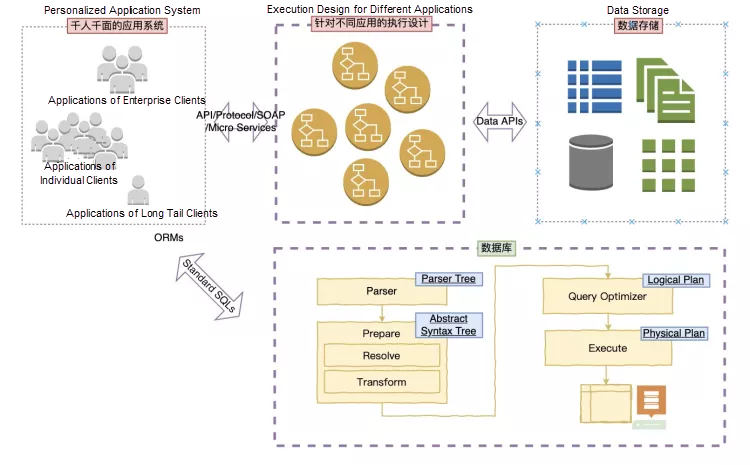
The SQL optimizer is essentially an implementation of a highly abstract data interface. Clients can use a more generic and easy-to-understand SQL language to operate and process data. They do not have to pay attention to and abstract their data interfaces, which facilitates their applications substantially.
This article introduces how MySQL 8.0 optimizer turns a simple string (SQL) into an execution sequence the database executor can understand and return the data to the client. The powerful optimizer allows clients not to pay attention to SQL optimization to obtain the required data faster, so the optimizer will make some equivalent changes to the original SQL. In the article entitled Details of the Latest Architecture of MySQL 8.0 Server Layer, we focused on the general introduction to the parser, optimizer, and executor at the Server layer, including the detailed display of some code structures and changes of the latest MySQL. We also demonstrated how MySQL optimizer simplifies nested Join optimization in logical transformation through the simple_joins function. This article explains the magic optimizer details step by step and how each step during optimization changes the final execution of SQL.
This article is based on the latest version MySQL 8.0.25. We will introduce the optimizer conversion part in two articles. The first one introduces the resolution and conversion processes of Setup and Resolve based on the basic structure. The second one introduces the more complex conversion process of complex subqueries, partitioned tables, and connections. The outline of this article is listed below:
The whole framework of conversion is a top-down or bottom-up process of Query_expression calling prepare function (sql/sql_resolver.cc) in Query_block according to the requirements of different conversion rules.
The prepare function first processes nullable table, which refers to the table that may contain null rows. Null rows can be propagated according to the JOIN relationship (top_join_list). If a table is determined to be nullable, some optimizations will degenerate. For example, the access method cannot be EQ_REF, the outer join cannot be optimized to inner join, etc.
SELECT
t1.c1
FROM t1,
(SELECT
t2.c1
FROM t2,
(SELECT
t3.c1
FROM t3
UNION
SELECT
t4.c1
FROM t4) AS t3a) AS t2a;The value of leaf_tables for each Query_block is 0 before being called by setup_table.
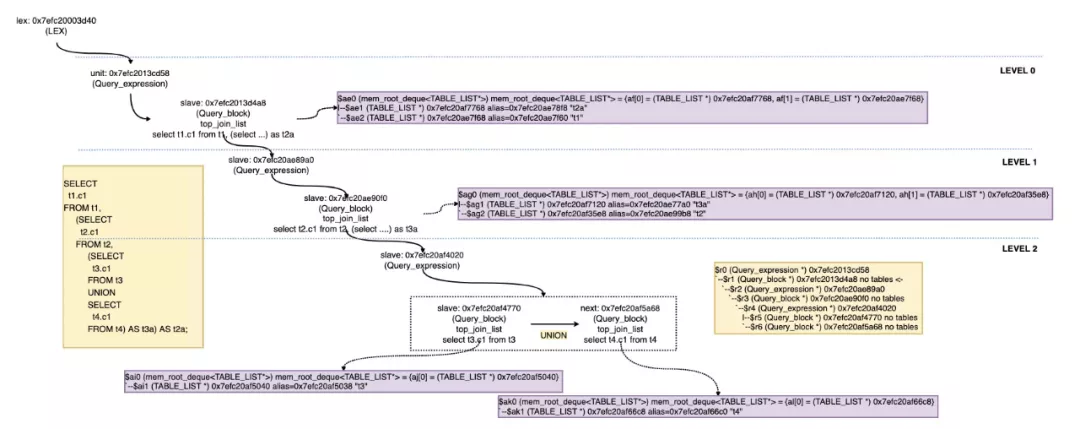
This function builds leaf_tables for subsequent optimization, including the lists of base tables and derived tables. setup_tables does not call recursively but only resolves the tables and counts the number of derived tables at this layer. Then, resolve_placeholder_tables()->resolve_derived()->derived(Query_expression)::prepare->Query_block::prepare will be called to recursively process Query_expression corresponding to the derived table.

Next, according to the call order of prepare, let's continue to look at the resolve_placeholder_tables function for derived table processing.
This function is used to process derived table, view, and table functions. If a table has been merged or called due to the use of transform_grouped_to_derived(), and it has used the materialized table method, it is ignored.

The role of resolve_derived()was discussed earlier, so we will focus on the merge_derived() function. merge_derived changes the Query_expression/Query_block framework structure and merge derived table or view into the query block.
1) Prerequisites for merge_derived transformation
Whether the query block in the outer layer allows merging operation (allow_merge_derived):
The query expression unit in which the entire derived table resides cannot (Query_expression::is_mergeable() ):
heuristic suggests merging (derived_query_expressionmerge_heuristic()):
2) Conversion process of merge_derived transformation
• Use the derived_table->nested_join structure to assist in handling OUTER JOIN situations.
• Merge the table in the derived table to the NESTED_JOIN struct (derived_table->merge_underlying_tables()).
• Connect all tables in the derived table to the table_list list of the parent query, and delete the derived table from the parent query.
• Recalculate all relevant data structures of the parent query (leaf_table_count, derived_table_count, table_func_count, materialized_derived_table_count, has_sj_nests, has_aj_nests, partitioned_table_count, cond_count, between_count, select_n_having_items)
• Propagation sets the parent query OPTION_SCHEMA_TABLE (add_base_options()), and if it is the inner table of the outer query JOIN, propagation sets the nullable property (propagate_nullability()).
• Merge the where condition of the derived table to the outer query (merge_where())
• Establish a reference to the column to be obtained by the derived table (create_field_translation())
• Delete the structure of the derived table from the parent query (exclude_level())
• Merge the renaming of columns or tables in derived table into the parent query (fix_tables_after_pullout()/repoint_contexts_of_join_nests())
• The table contained in the derived table has been merged into the parent query, so the position of the table in TABLE_LIST needs to be relocated (remap_tables()).
• After merging the derived table into the parent query, we need to modify all the references in the originally derived table to all columns in the derived table (fix_tables_after_pullout()).
• If the derived table contains an ORDER BY statement and the following conditions are met, the derived table will retain ORDER BY and merge it into the parent query. In other cases, ORDER BY will be ignored.
- The parent query allows sorting and only contains the derived table.
- Not a UNION
- The WHERE condition is allowed, but GROUP BY or aggregate functions are not.
- It is not orderly in itself.
The process is simplified below:
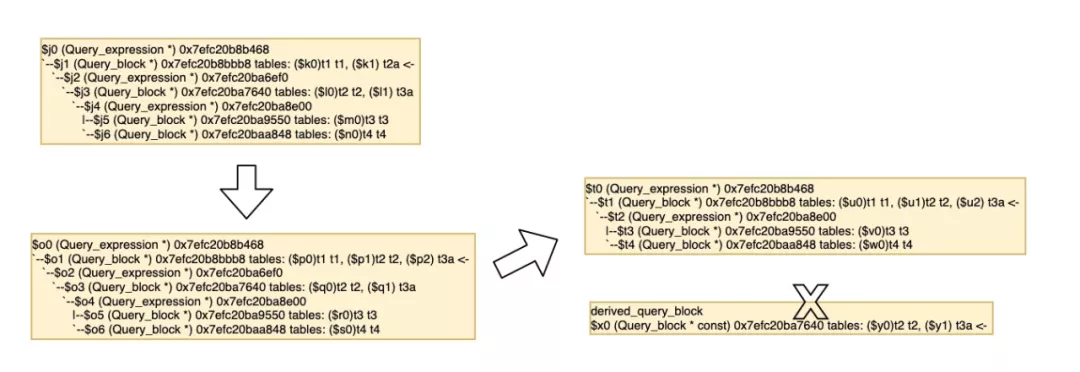
Diagram of the merge_derived Process
It seems that the official derived merge is still not perfect enough to perform bottom-up merging.
opt trace contained:
trace_derived.add_utf8_table(derived_table)
.add("select#", derived_query_block->select_number)
.add("merged", true);
trace_derived.add_alnum("transformations_to_derived_table", "removed_ordering");This optimization can be controlled by set optimizer_switch="derived_merge=on/off".
The remaining derived tables that cannot use the merge algorithm will be processed in materialized mode. However, only some preprocessing operations are done at this time, such as variable settings. The materialized execution is performed in the executor phase.
trace_derived.add_utf8_table(this)
.add("select#", derived->first_query_block()->select_number)
.add("materialized", true);If the query block contains a table function, the entire process is completed twice. The table of the table function is skipped for the first time, and the preceding logic is executed for the table of the table function at the second time. The external environment is resolved (relative to the table function) first because it is possible that the function parameters have dependencies on external derived tables.
trace_derived.add_utf8_table(this)
.add_utf8("function_name", func_name, func_name_len)
.add("materialized", true);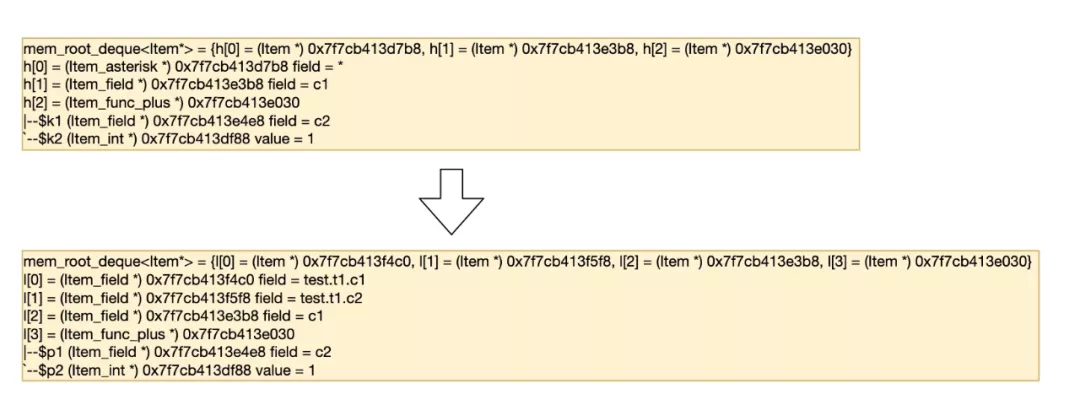
base_ref_items records the location of all items so other items of the query block can reference them. Other items can also directly refer to them through Item_ref and its subclasses, such as references to subqueries (Item_view_ref), aggregate functions (Item_aggregate_ref), and external query columns (Item_outer_ref), and reference assistance to subqueries that generate NULL values (Item_ref_null_helper).
We give an example below to help you understand the complex Item_outer_ref:

The following figure shows a relatively complex fixed field process with subquery. Some fields are associated with tables, and some need to add corresponding Item_xxx_ref references:
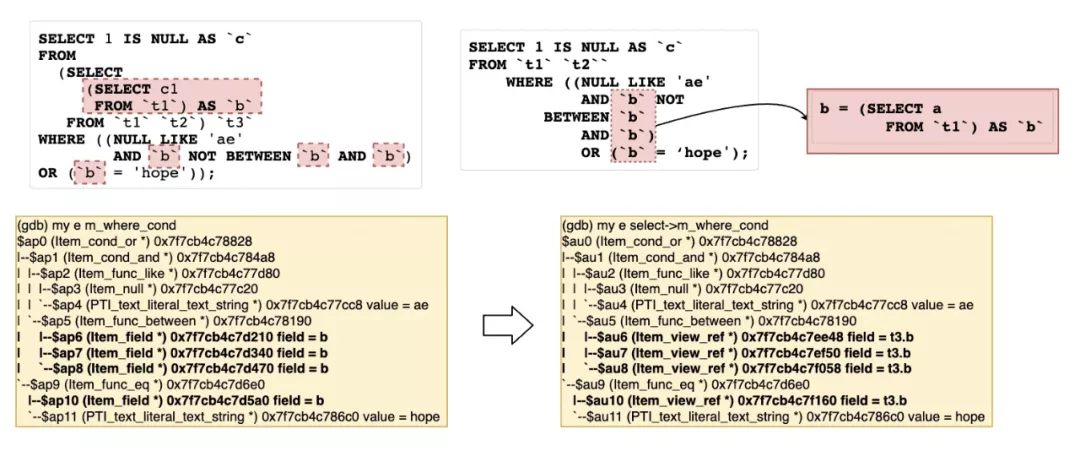
If there is nested_join, setup_join_cond will be called recursively for resolution and setting. Here, we also introduce the use of the simplify_const_condition function. If const Item that can be deleted is found, Item_func_true/Item_func_false will be used to replace the whole condition, as shown in the figure:

In the database query statement, the WITH ROLLUP statement can be added after the GROUP BY expression to ensure that a single query statement can analyze and count data at different levels.
SELECT YEAR,
country,
product,
SUM(profit) AS profit
FROM sales
GROUP BY YEAR,
country,
product WITH ROLLUP;
+------+---------+------------+--------+
| year | country | product | profit |
+------+---------+------------+--------+
| 2000 | Finland | Computer | 1500 |
| 2000 | Finland | Phone | 100 |
| 2000 | Finland | NULL | 1600 |
| 2000 | India | Calculator | 150 |
| 2000 | India | Computer | 1200 |
| 2000 | India | NULL | 1350 |
| 2000 | USA | Calculator | 75 |
| 2000 | USA | Computer | 1500 |
| 2000 | USA | NULL | 1575 |
| 2000 | NULL | NULL | 4525 |
| 2001 | Finland | Phone | 10 |
| 2001 | Finland | NULL | 10 |
| 2001 | USA | Calculator | 50 |
| 2001 | USA | Computer | 2700 |
| 2001 | USA | TV | 250 |
| 2001 | USA | NULL | 3000 |
| 2001 | NULL | NULL | 3010 |
| NULL | NULL | NULL | 7535 |
+------+---------+------------+--------+
This is equivalent to the following query:
SELECT *
FROM
(SELECT YEAR,
country,
product,
SUM(profit) AS profit
FROM sales
GROUP BY YEAR,
country,
product
UNION ALL SELECT YEAR,
country,
NULL,
SUM(profit) AS profit
FROM sales
GROUP BY YEAR,
country
UNION ALL SELECT YEAR,
NULL,
NULL,
SUM(profit) AS profit
FROM sales
GROUP BY YEAR
UNION ALL SELECT NULL,
NULL,
NULL,
SUM(profit) AS profit
FROM sales) AS sum_table
ORDER BY YEAR, country, product;
+------+---------+------------+--------+
| YEAR | country | product | profit |
+------+---------+------------+--------+
| NULL | NULL | NULL | 7535 |
| 2000 | NULL | NULL | 4525 |
| 2000 | Finland | NULL | 1600 |
| 2000 | Finland | Computer | 1500 |
| 2000 | Finland | Phone | 100 |
| 2000 | India | NULL | 1350 |
| 2000 | India | Calculator | 150 |
| 2000 | India | Computer | 1200 |
| 2000 | USA | NULL | 1575 |
| 2000 | USA | Calculator | 75 |
| 2000 | USA | Computer | 1500 |
| 2001 | NULL | NULL | 3010 |
| 2001 | Finland | NULL | 10 |
| 2001 | Finland | Phone | 10 |
| 2001 | USA | NULL | 3000 |
| 2001 | USA | Calculator | 50 |
| 2001 | USA | Computer | 2700 |
| 2001 | USA | TV | 250 |
+------+---------+------------+--------+Sorting has a NULL problem, so hierarchical summary is very difficult to complete. The group column and SQL complexity continuously change while ROLLUP can achieve the result easily. Let's look at what kind of conversion ROLLUP has done in the resolution process to achieve an amazing result.

find_order_in_list(): try to find columns that can be mapped in select fields. Otherwise, we will have to add the current column in all fields projected at the end and perform fix_fields.
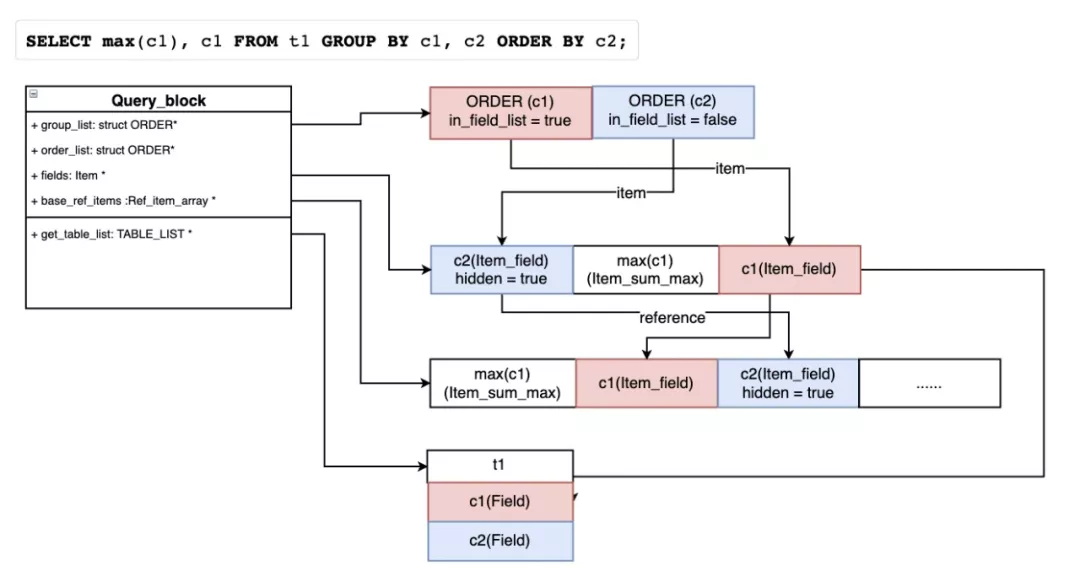
remove_redundant_subquery_clause: The expression of Table Subquery is usually IN/ANY/ALL/EXISTS/etc. If there is no aggregate function or Having clause, unnecessary ORDER/DISTINCT/GROUP BY can be deleted. This function supports REMOVE_ORDER, REMOVE_DISTINCT, and REMOVE_GROUP. If it is a subquery of SINGLEROW_SUBS, consider only deleting REMOVE_ORDER.
select c1 from t1 where t1.c2 in (select distinct c1 from t2 group by c1, c2 order by c1);
Convert to
select c1 from t1 where t1.c2 in (select c1 from t2);is_grouped() && hidden_group_field_count == 0 && olap == UNSPECIFIED_OLAP_TYPEFor example, in the following scenario:
SELECT DISTINCT c1, max(c2) from t1 group by c1;SELECT id,
release_year,
rating,
avg(rating) over(PARTITION BY release_year) AS year_avg
FROM tw;
+------+--------------+--------+-------------------+
| id | release_year | rating | year_avg |
+------+--------------+--------+-------------------+
| 1 | 2015 | 8 | 8.5 |
| 3 | 2015 | 9 | 8.5 |
| 2 | 2015 | 8.5 | 8.5 |
| 4 | 2016 | 8.2 | 8.3 |
| 5 | 2016 | 8.4 | 8.3 |
| 6 | 2017 | 7 | 7 |
+------+--------------+--------+-------------------+The execution process and results are similar to the following figure:
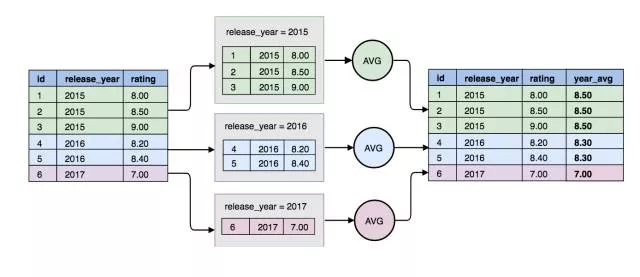
Let's take a look at what it did before the Query_block::prepare resolution process:
If select_lex->m_windows is not empty, call Window::setup_windows1.
Check the window function features (Window::check_window_functions1(THD thd, _block select))
This article focuses on some of the rule-based optimizations of the optimizer. It emphasizes more on the basic operators in SQL, such as the resolving, setting, and some obvious structural changes of elements like tables, columns, functions, aggregations, grouping, and sorting. The next article will continue to introduce the transformation of subquery, partitioned table, and JOIN operations. Please look forward to it.
A Deep-Dive into MySQL: An Exploration of the MySQL Data Dictionary
ApsaraDB - May 16, 2022
ApsaraDB - May 18, 2022
Morningking - September 26, 2023
ApsaraDB - May 30, 2023
ApsaraDB - October 19, 2023
ApsaraDB - December 25, 2024
 PolarDB for MySQL
PolarDB for MySQL
Alibaba Cloud PolarDB for MySQL is a cloud-native relational database service 100% compatible with MySQL.
Learn More Serverless Workflow
Serverless Workflow
Visualization, O&M-free orchestration, and Coordination of Stateful Application Scenarios
Learn More AnalyticDB for MySQL
AnalyticDB for MySQL
AnalyticDB for MySQL is a real-time data warehousing service that can process petabytes of data with high concurrency and low latency.
Learn More ApsaraDB RDS for SQL Server
ApsaraDB RDS for SQL Server
An on-demand database hosting service for SQL Server with automated monitoring, backup and disaster recovery capabilities
Learn MoreMore Posts by ApsaraDB